如何使用 context
context 使用起来非常方便。源码里对外提供了一个创建根节点 context 的函数:
1
|
func Background() Context
|
background 是一个空的 context, 它不能被取消,没有值,也没有超时时间。
有了根节点 context,又提供了四个函数创建子节点 context:
1
2
3
4
|
func WithCancel(parent Context) (ctx Context, cancel CancelFunc)
func WithDeadline(parent Context, deadline time.Time) (Context, CancelFunc)
func WithTimeout(parent Context, timeout time.Duration) (Context, CancelFunc)
func WithValue(parent Context, key, val interface{}) Context
|
context 会在函数传递间传递。只需要在适当的时间调用 cancel 函数向 goroutines 发出取消信号或者调用 Value 函数取出 context 中的值。
在使用 Context 的时候,有一些约定俗成的规则。
- 一般函数使用 Context 的时候,会把这个参数放在第一个参数的位置。
- 从来不把 nil 当做 Context 类型的参数值,可以使用 context.Background() 创建一个空的上下文对象,也不要使用 nil。
- Context 只用来临时做函数之间的上下文透传,不能持久化 Context 或者把 Context 长久保存。把 Context 持久化到数据库、本地文件或者全局变量、缓存中都是错误的用法。
- key 的类型不应该是字符串类型或者其它内建类型,否则容易在包之间使用 Context 时候产生冲突。使用 WithValue 时,key 的类型应该是自己定义的类型。
- 常常使用 struct{}作为底层类型定义 key 的类型。对于 exported key 的静态类型,常常是接口或者指针。这样可以尽量减少内存分配。
传递共享的数据
对于 Web 服务端开发,往往希望将一个请求处理的整个过程串起来,这就非常依赖于 Thread Local(对于 Go 可理解为单个协程所独有) 的变量,而在 Go 语言中并没有这个概念,因此需要在函数调用的时候传递 context。
1
2
3
4
5
6
7
8
9
10
11
12
13
14
15
16
17
18
19
20
21
22
23
|
package main
import (
"context"
"fmt"
)
func main() {
ctx := context.Background()
process(ctx)
ctx = context.WithValue(ctx, "traceId", "qcrao-2019")
process(ctx)
}
func process(ctx context.Context) {
traceId, ok := ctx.Value("traceId").(string)
if ok {
fmt.Printf("process over. trace_id=%s\n", traceId)
} else {
fmt.Printf("process over. no trace_id\n")
}
}
|
运行结果:
1
2
|
process over. no trace_id
process over. trace_id=qcrao-2019
|
第一次调用 process 函数时,ctx 是一个空的 context,自然取不出来 traceId。第二次,通过 WithValue 函数创建了一个 context,并赋上了 traceId 这个 key,自然就能取出来传入的 value 值。
当然,现实场景中可能是从一个 HTTP 请求中获取到的 Request-ID。所以,下面这个样例可能更适合:
1
2
3
4
5
6
7
8
9
10
11
12
13
14
15
16
17
18
19
20
21
22
23
24
25
26
27
28
29
30
31
32
33
34
35
|
const requestIDKey int = 0
func WithRequestID(next http.Handler) http.Handler {
return http.HandlerFunc(
func(rw http.ResponseWriter, req *http.Request) {
// 从 header 中提取 request-id
reqID := req.Header.Get("X-Request-ID")
// 创建 valueCtx。使用自定义的类型,不容易冲突
ctx := context.WithValue(
req.Context(), requestIDKey, reqID)
// 创建新的请求
req = req.WithContext(ctx)
// 调用 HTTP 处理函数
next.ServeHTTP(rw, req)
}
)
}
// 获取 request-id
func GetRequestID(ctx context.Context) string {
ctx.Value(requestIDKey).(string)
}
func Handle(rw http.ResponseWriter, req *http.Request) {
// 拿到 reqId,后面可以记录日志等等
reqID := GetRequestID(req.Context())
...
}
func main() {
handler := WithRequestID(http.HandlerFunc(Handle))
http.ListenAndServe("/", handler)
}
|
取消 goroutine
我们先来设想一个场景:打开外卖的订单页,地图上显示外卖小哥的位置,而且是每秒更新 1 次。app 端向后台发起 websocket 连接(现实中可能是轮询)请求后,后台启动一个协程,每隔 1 秒计算 1 次小哥的位置,并发送给端。如果用户退出此页面,则后台需要“取消”此过程,退出 goroutine,系统回收资源。
后端可能的实现如下:
1
2
3
4
5
6
7
|
func Perform() {
for {
calculatePos()
sendResult()
time.Sleep(time.Second)
}
}
|
如果需要实现“取消”功能,并且在不了解 context 功能的前提下,可能会这样做:给函数增加一个指针型的 bool 变量,在 for 语句的开始处判断 bool 变量是发由 true 变为 false,如果改变,则退出循环。
上面给出的简单做法,可以实现想要的效果,没有问题,但是并不优雅,并且一旦协程数量多了之后,并且各种嵌套,就会很麻烦。优雅的做法,自然就要用到 context。
1
2
3
4
5
6
7
8
9
10
11
12
13
14
|
func Perform(ctx context.Context) {
for {
calculatePos()
sendResult()
select {
case <-ctx.Done():
// 被取消,直接返回
return
case <-time.After(time.Second):
// block 1 秒钟
}
}
}
|
主流程可能是这样的:
1
2
3
4
5
6
|
ctx, cancel := context.WithTimeout(context.Background(), time.Hour)
go Perform(ctx)
// ……
// app 端返回页面,调用cancel 函数
cancel()
|
注意一个细节,WithTimeOut 函数返回的 context 和 cancelFun 是分开的。context 本身并没有取消函数,这样做的原因是取消函数只能由外层函数调用,防止子节点 context 调用取消函数,从而严格控制信息的流向:由父节点 context 流向子节点 context。
防止 goroutine 泄漏
前面那个例子里,goroutine 还是会自己执行完,最后返回,只不过会多浪费一些系统资源。这里改编一个“如果不用 context 取消,goroutine 就会泄漏的例子”,来自参考资料:【避免协程泄漏】。
1
2
3
4
5
6
7
8
9
10
11
12
|
func gen() <-chan int {
ch := make(chan int)
go func() {
var n int
for {
ch <- n
n++
time.Sleep(time.Second)
}
}()
return ch
}
|
这是一个可以生成无限整数的协程,但如果我只需要它产生的前 5 个数,那么就会发生 goroutine 泄漏:
1
2
3
4
5
6
7
8
9
|
func main() {
for n := range gen() {
fmt.Println(n)
if n == 5 {
break
}
}
// ……
}
|
当 n == 5 的时候,直接 break 掉。那么 gen 函数的协程就会执行无限循环,永远不会停下来。发生了 goroutine 泄漏。
用 context 改进这个例子:
1
2
3
4
5
6
7
8
9
10
11
12
13
14
15
16
17
18
19
20
21
22
23
24
25
26
27
28
29
30
|
func gen(ctx context.Context) <-chan int {
ch := make(chan int)
go func() {
var n int
for {
select {
case <-ctx.Done():
return
case ch <- n:
n++
time.Sleep(time.Second)
}
}
}()
return ch
}
func main() {
ctx, cancel := context.WithCancel(context.Background())
defer cancel() // 避免其他地方忘记 cancel,且重复调用不影响
for n := range gen(ctx) {
fmt.Println(n)
if n == 5 {
cancel()
break
}
}
// ……
}
|
增加一个 context,在 break 前调用 cancel 函数,取消 goroutine。gen 函数在接收到取消信号后,直接退出,系统回收资源。
如何将 context 集成到 API
在将 context 集成到 API 中时,要记住的最重要的一点是,它的作用域是请求级别的。例如,沿单个数据库查询存在是有意义的,但沿数据库对象存在则没有意义。
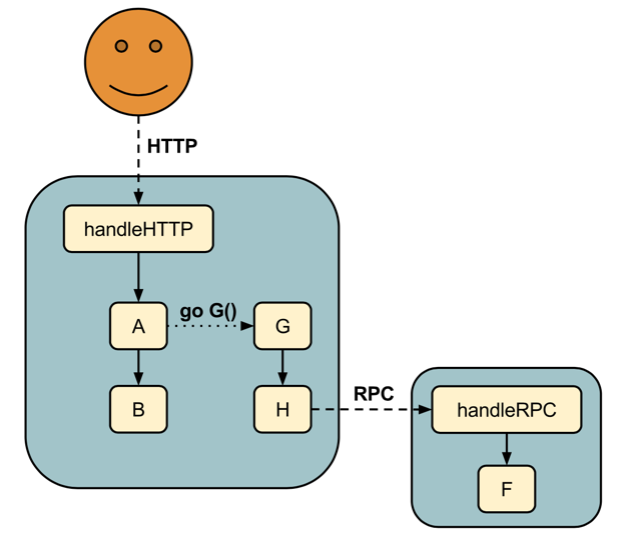
目前有两种方法可以将 context 对象集成到 API 中:
-
The first parameter of a function call
首参数传递 context 对象,比如,参考 net 包 Dialer.DialContext。此函数执行正常的 Dial 操作,但可以通过 context 对象取消函数调用。

-
Optional config on a request structure
在第一个 request 对象中携带一个可选的 context 对象。例如 net/http 库的 Request.WithContext,通过携带给定的 context 对象,返回一个新的 Request 对象。

Do not store Contexts inside a struct type
Do not store Contexts inside a struct type; instead, pass a Context explicitly to each function that needs it. The Context should be the first parameter, typically named ctx:

Incoming requests to a server should create a Context.
使用 context 的一个很好的心智模型是它应该在程序中流动,应该贯穿你的代码。这通常意味着您不希望将其存储在结构体之中。它从一个函数传递到另一个函数,并根据需要进行扩展。理想情况下,每个请求都会创建一个 context 对象,并在请求结束时过期。
不存储上下文的一个例外是,当您需要将它放入一个结构中时,该结构纯粹用作通过通道传递的消息。如下例所示。

推荐 context 作为函数参数传递
让我们先看下在函数中传递 context:
1
2
3
4
5
6
7
8
9
10
11
12
13
14
15
|
type Worker struct { /*…*/ }
type Work struct { /*…*/ }
func New() *Worker {
return &Worker{}
}
func (w *Worker) Fetch(ctx context.Context) (*Work, error) {
_ = ctx // A per-call ctx is used for cancellation, deadlines, and metadata.
}
func (w *Worker) Process(ctx context.Context, w*Work) error {
_ = ctx // A per-call ctx is used for cancellation, deadlines, and metadata.
}
|
这里 (*Worker).Fetch 和 (*Worker).Process 都直接将 context 作为函数第一个参数。这样从 context 的生成到结束,调用方可以很清晰地知道 context 的传递路线。
将 context 存储到 strcut 所带来的一些困惑
在结构体中嵌套 context 来实现上面的 Worker 示例,调用者对所使用的 context 生命周期产生迷惑:
1
2
3
4
5
6
7
8
9
10
11
12
13
14
15
|
type Worker struct {
ctx context.Context
}
func New(ctx context.Context) *Worker {
return &Worker{ctx: ctx}
}
func (w *Worker) Fetch() (*Work, error) {
_ = w.ctx // A shared w.ctx is used for cancellation, deadlines, and metadata.
}
func (w *Worker) Process(w*Work) error {
_ = w.ctx // A shared w.ctx is used for cancellation, deadlines, and metadata.
}
|
(*Worker).Fetch 和 (*Worker).Process 方法同时使用了 Worker 结构体中的 context ,这种情况下使得调用方无法定义不同的 context ,比如有调用方想用 WitchCancel,有的想用 WithDeadline,也很难理解上面传来的 context 的作用是 cancel?还是 deadline?调用者所使用 context 的生命周期被绑定到了一个共享的 context 上面。
特殊情况:保留向后兼容性
当 go 1.7 版本发布时,大量的的 API 需要以向后兼容的方式支持 context.Context,例如,net/http 的 Client 方法(例如Get和Do)是使用 context 的典范。使用这些方法发送的 http 请求都将受益于 context.Context 附带的 WithDeadline,WithCancel 和 WithValue 等方法支持。
一般有两种方式能够在支持 context.Context 的同时保持代码的向后兼容:
- 在 struct 中添加 context (稍后我们将看到);
- 复制原有函数,在函数第一个参数中使用 context,举个栗子,database/sql 这个 package 的 Query 方法的签名一直是:
1
|
func (db *DB) Query(query string, args ...interface{}) (*Rows, error)
|
当 context package 引入的时候,Go team 新增了这样一个函数:
1
|
func (db *DB) QueryContext(ctx context.Context, query string, args ...interface{}) (*Rows, error)
|
并且只修改了一处代码:
1
2
3
|
func (db *DB) Query(query string, args ...interface{}) (*Rows, error) {
return db.QueryContext(context.Background(), query, args...)
}
|
通过这种方式,Go team 能够在平滑地升级一个 package 的同时不对代码的可读性、兼容性造成影响。类似的代码在 golang 源码中随处可见。更多的保持代码兼容性的讨论可见 [Go team 关于如何保持 Go Modules 兼容性的一些实践]。
然而在某些情况下,比如 API 公开了大量 function,重写所有函数是不切实际的。
package net/http 选择在 struct 中添加 context.Context,这是一个结构体嵌套 context 比较恰当的范例。先让我们看下 net/http 的 Do 函数。在引入 context 之前,Do 的定义如下:
1
|
func (c *Client) Do(req*Request) (*Response, error)
|
在 1.7 引入 context 后,为了遵循 net/http 这种标准库的向后兼容原则,考虑到该核心库所包含的函数过于多,maintainers 选择在结构体 http.Request 中添加 context.Context。
1
2
3
4
5
6
7
8
9
10
11
12
13
14
15
|
type Request struct {
ctx context.Context
// ...
}
func NewRequestWithContext(ctx context.Context, method, url string, body io.Reader) (*Request, error) {
// Simplified for brevity of this article.
return &Request{
ctx: ctx,
// ...
}
}
func (c *Client) Do(req*Request) (*Response, error)
|
在修改大量 API 以支持 context 时,在结构体中添加 context.Context 是有意义的, 如上所述。但是,记住首先要考虑复制函数对 context 进行支持,在不牺牲实用性和理解性的前提下向后兼容上下文:
1
2
3
4
5
6
7
|
func (c *Client) Call() error {
return c.CallContext(context.Background())
}
func (c *Client) CallContext(ctx context.Context) error {
// ...
}
|
context.WithValue
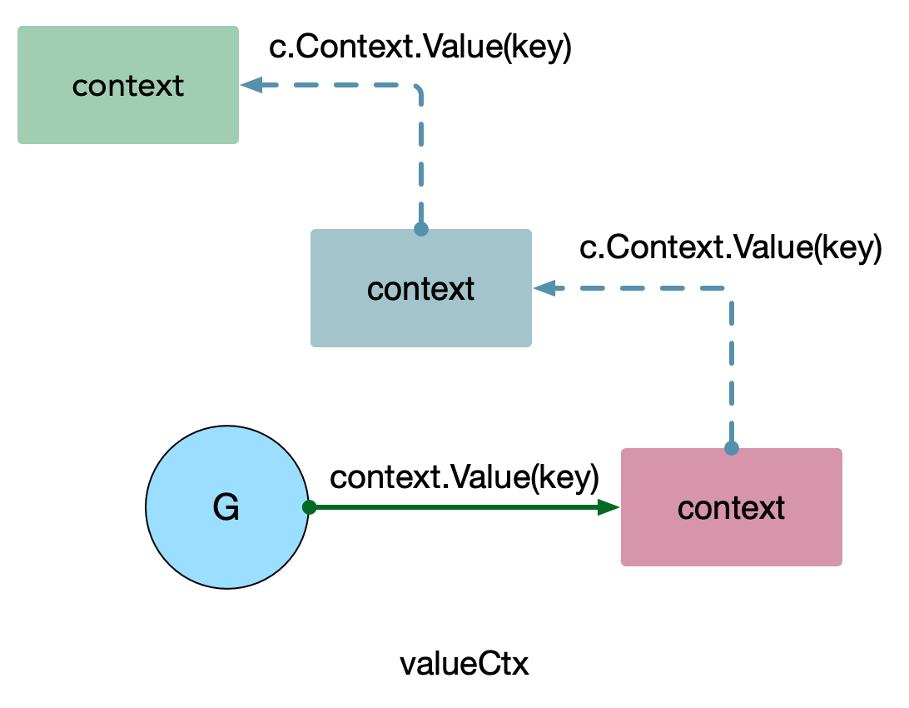
context.WithValue 内部基于 valueCtx 实现:

为了实现不断的 WithValue,构建新的 context,内部在查找 key 时候,使用递归方式不断从当前,从父节点寻找匹配的 key,直到 root context(Backgrond 和 TODO Value 函数会返回 nil)。

比如我们新建了一个基于 context.Background() 的 ctx1,携带了一个 map 的数据,map 中包含了 “k1”: “v1” 的一个键值对,ctx1 被两个 goroutine 同时使用作为函数签名传入,如果我们修改了 这个map,会导致另外进行读 context.Value 的 goroutine 和修改 map 的 goroutine,在 map 对象上产生 data race。因此我们要使用 copy-on-write 的思路,解决跨多个 goroutine 使用数据、修改数据的场景。
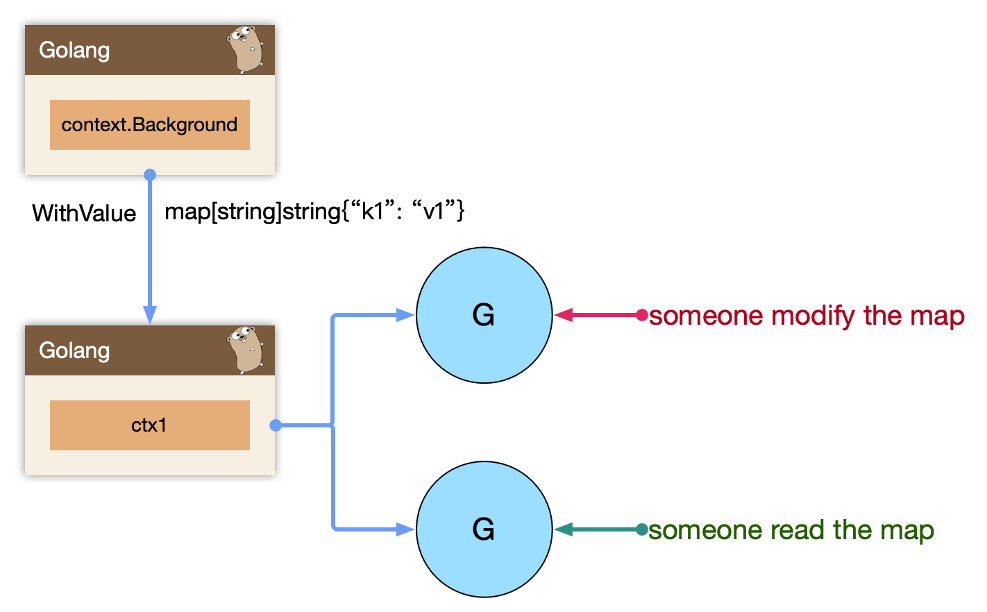
Replace a Context using WithCancel, WithDeadline, WithTimeout, or WithValue.
COW: 从 ctx1 中获取 map1(可以理解为 v1 版本的 map 数据)。构建一个新的 map 对象 map2,复制所有 map1 数据,同时追加新的数据 “k2”: “v2” 键值对,使用 context.WithValue 创建新的 ctx2,ctx2 会传递到其他的 goroutine 中。这样各自读取的副本都是自己的数据,写行为追加的数据,在 ctx2 中也能完整读取到,同时也不会污染 ctx1 中的数据。
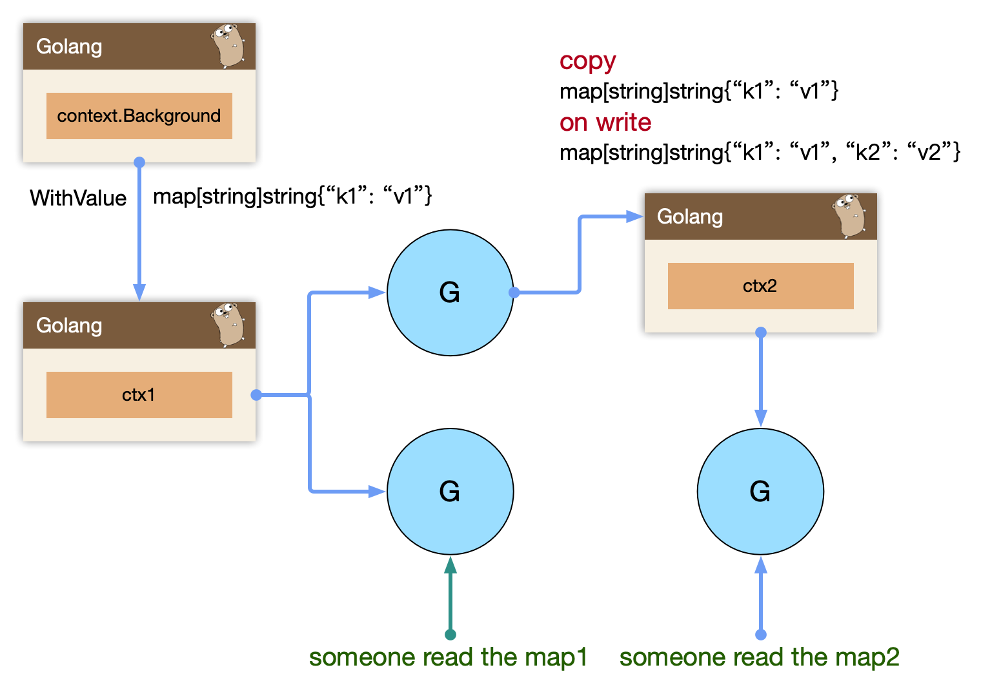
The chain of function calls between them must propagate the Context.
Debugging or tracing data is safe to pass in a Context
context.WithValue 方法允许上下文携带请求范围的数据。这些数据必须是安全的,以便多个 goroutine 同时使用。这里的数据,更多是面向请求的元数据,不应该作为函数的可选参数来使用(比如 context 里面挂了一个sql.Tx 对象,传递到 Dao 层使用),因为元数据相对函数参数更加是隐含的,面向请求的。而参数是更加显式的。
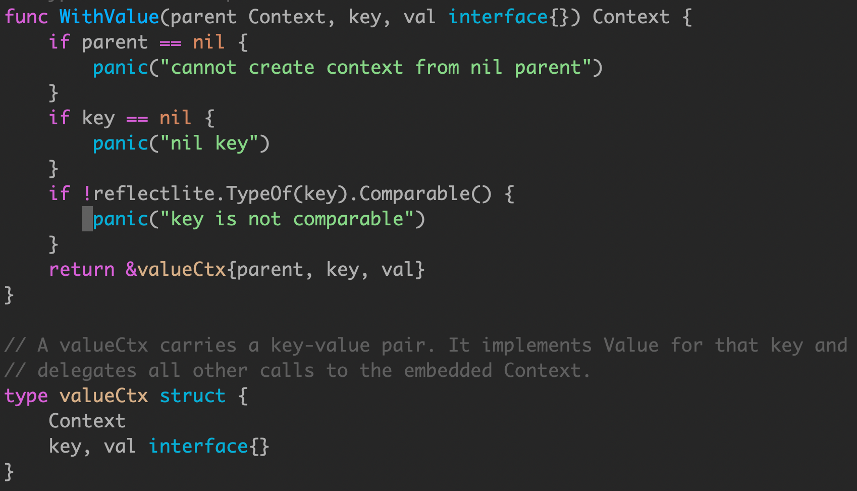
同一个 context 对象可以传递给在不同 goroutine 中运行的函数;上下文对于多个 goroutine 同时使用是安全的。对于值类型最容易犯错的地方,在于 context value 应该是 immutable 的,每次重新赋值应该是新的 context,即: context.WithValue(ctx, oldvalue)
https://pkg.go.dev/google.golang.org/grpc/metadata
Context.Value should inform, not control
Use context values only for request-scoped data that transits processes and APIs, not for passing optional parameters to functions.
比如 染色,API 重要性,Trace
https://github.com/go-kratos/kratos/blob/master/pkg/net/metadata/key.go
When a Context is canceled, all Contexts derived from it are also canceled
当一个 context 被取消时,从它派生的所有 context 也将被取消。WithCancel(ctx) 参数 ctx 认为是 parent ctx,在内部会进行一个传播关系链的关联。Done() 返回 一个 chan,当我们取消某个parent context, 实际上上会递归层层 cancel 掉自己的 child context 的 done chan 从而让整个调用链中所有监听 cancel 的 goroutine退出。
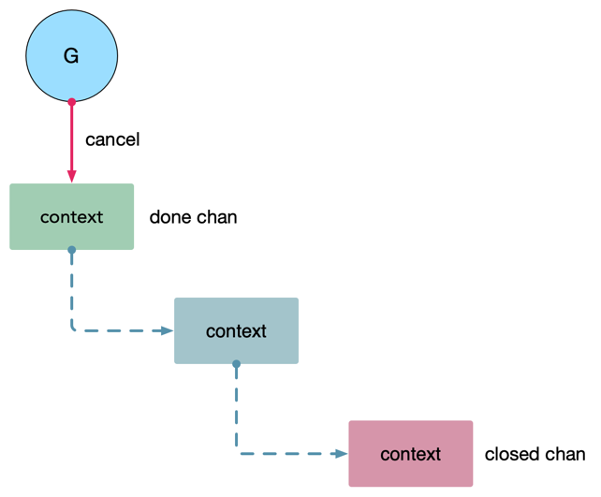
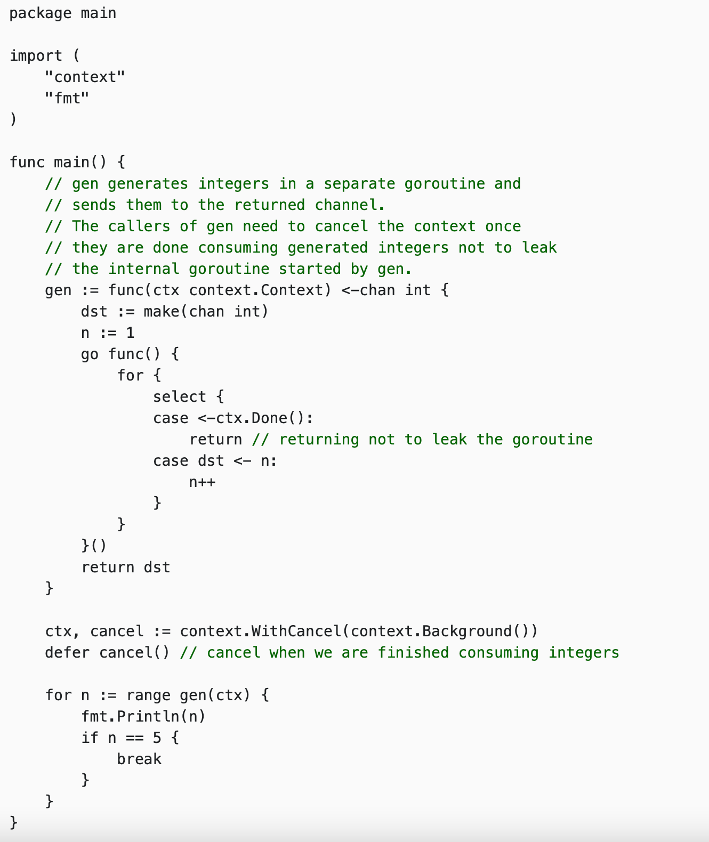
All blocking/long operations should be cancelable
如果要实现一个超时控制,通过上面的context 的parent/child 机制,其实我们只需要启动一个定时器,然后在超时的时候,直接将当前的 context 给 cancel 掉,就可以实现监听在当前和下层的额context.Done() 的 goroutine 的退出。
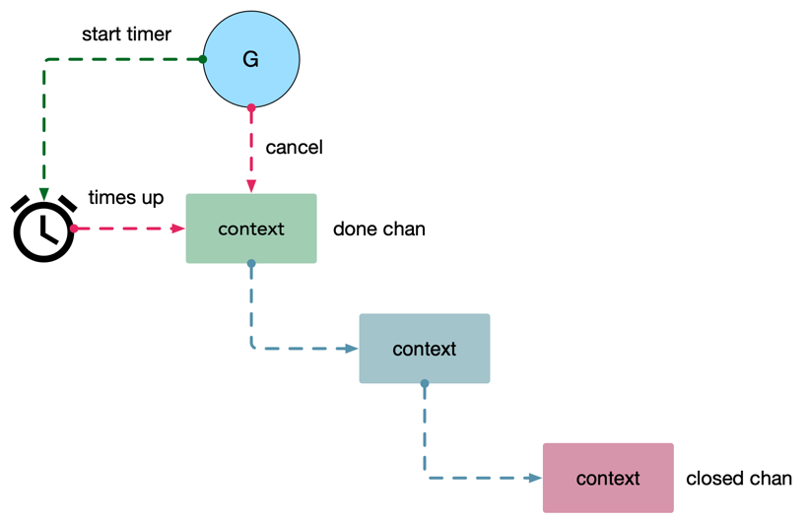
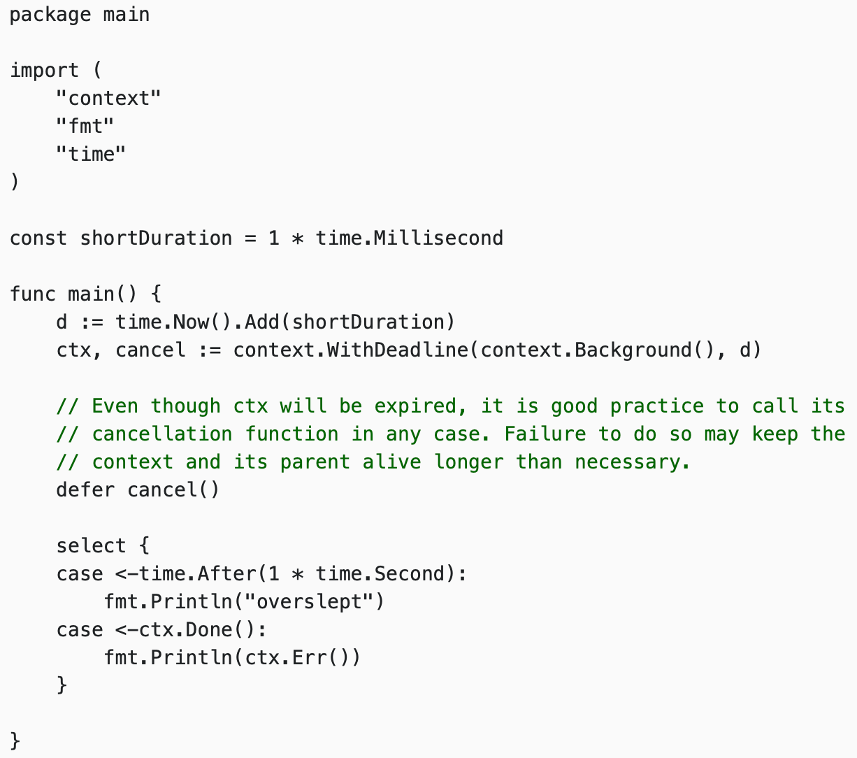
Final Notes
- Incoming requests to a server should create a Context.
- 一个RPC服务,当有请求进来时,第一个要做的事情就是创建一个context
- 如果设定超时就用withtimeout.
- 如果没有设定超时,就用withcanncel.
- 一般建议一定要设置超时.
- Outgoing calls to servers should accept a Context.
- 调用其他服务的时候,一定要显式传递context.
- Do not store Contexts inside a struct type; instead, pass a Context explicitly to each function that needs it.
- The chain of function calls between them must propagate the Context.
- 如果使用context.withvalue,可以在context内部创建级联关系,一个取消,就全部取消.
- Replace a Context using WithCancel, WithDeadline, WithTimeout, or WithValue.
- 只能替换context,而不能更改context.每次使用with的时候,都是创建新context.value里面的数据是不可变更的.包括断言出来拿的结构体,把里面的字段改值,也不会变更
- When a Context is canceled, all Contexts derived from it are also canceled.
- 如果一个context取消,级联context取消.
- The same Context may be passed to functions running in different goroutines; Contexts are safe for simultaneous use by multiple goroutines.
- Do not pass a nil Context, even if a function permits it. Pass a TODO context if you are unsure about which Context to use.
- 不要传nil到context中,如果不知道要传什么,请传context.todo.
- Use context values only for request-scoped data that transits processes and APIs, not for passing optional parameters to functions.
- 不要在context中带和业务逻辑相关的数据,如果是业务逻辑相关的内容,建议显式传递.
- All blocking/long operations should be cancelable.
- 所有耗时很长,会阻塞的操作一定要传递context,让其可以被取消.
- 计算密集型,系统调用,网络消息.
- Context.Value obscures your program’s flow.
- context的value的值不应该影响你的业务逻辑.
- Context.Value should inform, not control.
- Try not to use context.Value.
- 最好不用context.Value,而是显式传递参数.
https://talks.golang.org/2014/gotham-context.slide#1
context 真的这么好吗
读完全文,你一定有这种感觉:context 就是为 server 而设计的。说什么处理一个请求,需要启动多个 goroutine 并行地去处理,并且在这些 goroutine 之间还要传递一些共享的数据等等,这些都是写一个 server 要做的事。
没错,Go 很适合写 server,但它终归是一门通用的语言。你在用 Go 做 Leetcode 上面的题目的时候,肯定不会认为它和一般的语言有什么差别。所以,很多特性好不好,应该从 Go 只是一门普通的语言,很擅长写 server 的角度来看。
从这个角度来看,context 并没有那么美好。Go 官方建议我们把 Context 作为函数的第一个参数,甚至连名字都准备好了。这造成一个后果:因为我们想控制所有的协程的取消动作,所以需要在几乎所有的函数里加上一个 Context 参数。很快,我们的代码里,context 将像病毒一样扩散的到处都是。
在参考资料【Go2 应该去掉 context】这篇英文博客里,作者甚至调侃说:如果要把 Go 标准库的大部分函数都加上 context 参数的话,例如下面这样:
1
|
n, err := r.Read(context.TODO(), p)
|
就给我来一枪吧!
原文是这样说的:put a bullet in my head, please.我当时看到这句话的时候,会心一笑。这可能就是陶渊明说的:每有会意,便欣然忘食。当然,我是在晚饭会看到这句话的。
为了表达自己对 context 并没有什么好感,作者接着又说了一句:If you use ctx.Value in my (non-existent) company, you’re fired. 简直太幽默了,哈哈。
另外,像 WithCancel、WithDeadline、WithTimeout、WithValue 这些创建函数,实际上是创建了一个个的链表结点而已。我们知道,对链表的操作,通常都是 O(n) 复杂度的,效率不高。
那么,context 包到底解决了什么问题呢?答案是:cancelation。仅管它并不完美,但它确实很简洁地解决了问题。
打印context引起panic
分析问题
下面是出现net/http context panic的问题代码,代码的逻辑很简单,就是定义一个api,然后打印context而已。把服务运行起来后,我们可以用ab, wrk来进行压测,来制造data race竞争的场景。
1
2
3
4
5
6
7
8
9
10
11
12
13
14
15
16
17
18
19
20
|
// xiaorui.cc
package main
import (
"fmt"
"net/http"
)
func panic(w http.ResponseWriter, r *http.Request) {
fmt.Printf("%+v", r.Context())
}
func main() {
http.HandleFunc("/", panic)
err := http.ListenAndServe(":9090", nil)
if err != nil {
fmt.Println(err)
}
}
|
下面是wrk压测时,net/http服务的异常信息。
1
2
3
4
5
6
7
8
9
10
11
12
13
14
15
16
17
18
19
20
21
22
23
24
25
26
27
28
29
30
31
32
33
34
35
36
37
38
39
40
41
42
43
44
45
46
47
48
49
50
51
52
53
54
55
56
57
58
59
60
61
62
63
64
65
66
67
68
69
70
71
72
73
|
// xiaorui.cc
fatal error: concurrent map read and map write
context.Background.WithValue(&http.contextKey{name:"http-server"}, &http.Server{Addr:":9090", Handler:http.Handler(nil), TLSConfig:(*tls.Config)(0xc000062780), ReadTimeout:0, ReadHeaderTimeout:0, WriteTimeout:0, IdleTimeout:0, MaxHeaderBytes:0, TLSNextProto:map[string]func(*http.Server, *tls.Conn, http.Handler){"h2":(func(*http.Server, *tls.Conn, http.Handler))(0x120b620)}, ConnState:(func(net.Conn, http.ConnState))(nil), ErrorLog:(*log.Logger)(nil), disableKeepAlives:0, inShutdown:0, nextProtoOnce:sync.Once{m:sync.Mutex{state:0, sema:0x0}, done:0x1}, nextProtoErr:error(nil), mu:sync.Mutex{state:0, sema:0x0}, listeners:map[*net.Listener]struct {}{(*net.Listener)(0xc00007ccb0):struct {}{}}, activeConn:map[*http.conn]struct {}{(*http.conn)(0xc00009cb40):struct {}{}, (*http.conn)(0xc00009d2c0):struct {}{}, (*http.conn)(0xc00009d540):struct {}{}, (*http.conn)(0xc00009dcc0):struct {}{}, (*http.conn)(0xc00009cd20):struct {}{}, (*http.conn)(0xc00009d5e0):struct {}...
xiaorui.cc
goroutine 32 [running]:
runtime.throw(0x12b35e3, 0x21)
/usr/local/go/src/runtime/panic.go:608 +0x72 fp=0xc00018a858 sp=0xc00018a828 pc=0x102b892
runtime.mapaccess2(0x1255800, 0xc000080ea0, 0xc00018a978, 0x14bf328, 0xc0000ac868)
/usr/local/go/src/runtime/map.go:453 +0x223 fp=0xc00018a8a0 sp=0xc00018a858 pc=0x100ed93
reflect.mapaccess(0x1255800, 0xc000080ea0, 0xc00018a978, 0x12afece)
/usr/local/go/src/runtime/map.go:1249 +0x3f fp=0xc00018a8d8 sp=0xc00018a8a0 pc=0x1010adf
reflect.Value.MapIndex(0x1255800, 0xc000083280, 0x1b5, 0x1288180, 0xc00009da40, 0x36, 0x1257ae0, 0x14bf328, 0xb9)
/usr/local/go/src/reflect/value.go:1111 +0x11d fp=0xc00018a958 sp=0xc00018a8d8 pc=0x1099b7d
fmt.(*pp).printValue(0xc000188180, 0x1255800, 0xc000083280, 0x1b5, 0x76, 0x2)
/usr/local/go/src/fmt/print.go:757 +0xf43 fp=0xc00018ab38 sp=0xc00018a958 pc=0x10aa853
fmt.(*pp).printValue(0xc000188180, 0x12a0720, 0xc0000831e0, 0x199, 0xc000000076, 0x1)
/usr/local/go/src/fmt/print.go:783 +0x1ce9 fp=0xc00018ad18 sp=0xc00018ab38 pc=0x10ab5f9
fmt.(*pp).printValue(0xc000188180, 0x129ed00, 0xc0000831e0, 0x16, 0x76, 0x0)
/usr/local/go/src/fmt/print.go:853 +0x1b2c fp=0xc00018aef8 sp=0xc00018ad18 pc=0x10ab43c
fmt.(*pp).printArg(0xc000188180, 0x129ed00, 0xc0000831e0, 0x76)
/usr/local/go/src/fmt/print.go:689 +0x2b7 fp=0xc00018af90 sp=0xc00018aef8 pc=0x10a91a7
fmt.(*pp).doPrintf(0xc000188180, 0x12afaf0, 0x16, 0xc00018b108, 0x3, 0x3)
/usr/local/go/src/fmt/print.go:1003 +0x166 fp=0xc00018b078 sp=0xc00018af90 pc=0x10acde6
fmt.Sprintf(0x12afaf0, 0x16, 0xc00018b108, 0x3, 0x3, 0x0, 0x0)
/usr/local/go/src/fmt/print.go:203 +0x66 fp=0xc00018b0d0 sp=0xc00018b078 pc=0x10a5b26
context.(*valueCtx).String(0xc000080e10, 0x12be400, 0xc0001880c0)
/usr/local/go/src/context/context.go:486 +0xab fp=0xc00018b148 sp=0xc00018b0d0 pc=0x11121bb
fmt.(*pp).handleMethods(0xc0001880c0, 0x76, 0x1)
/usr/local/go/src/fmt/print.go:603 +0x27c fp=0xc00018b1d8 sp=0xc00018b148 pc=0x10a8cac
fmt.(*pp).printArg(0xc0001880c0, 0x1274ce0, 0xc000080e10, 0x76)
/usr/local/go/src/fmt/print.go:686 +0x203 fp=0xc00018b270 sp=0xc00018b1d8 pc=0x10a90f3
fmt.(*pp).doPrintf(0xc0001880c0, 0x12afaf0, 0x16, 0xc00018b3e8, 0x3, 0x3)
...
fmt.(*pp).printArg(0xc000188000, 0x1274ce0, 0xc000114480, 0xc000000076)
/usr/local/go/src/fmt/print.go:1003 +0x166 fp=0xc00018b638 sp=0xc00018b550 pc=0x10acde6
fmt.Sprintf(0x12ad1be, 0xd, 0xc0001106c8, 0x1, 0x1, 0xc00011e080, 0xc0001106f8)
/usr/local/go/src/fmt/print.go:203 +0x66 fp=0xc00018b690 sp=0xc00018b638 pc=0x10a5b26
context.(*cancelCtx).String(0xc000116640, 0x12be400, 0xc000188300)
/usr/local/go/src/context/context.go:343 +0x7d fp=0xc00018b6e8 sp=0xc00018b690 pc=0x111158d
fmt.(*pp).handleMethods(0xc000188300, 0xc000000076, 0x1034601)
/usr/local/go/src/fmt/print.go:603 +0x27c fp=0xc00018b778 sp=0xc00018b6e8 pc=0x10a8cac
fmt.(*pp).printArg(0xc000188300, 0x12785e0, 0xc000116640, 0xc000000076)
/usr/local/go/src/fmt/print.go:686 +0x203 fp=0xc00018b810 sp=0xc00018b778 pc=0x10a90f3
fmt.(*pp).doPrintf(0xc000188300, 0x12ad1be, 0xd, 0xc00018b988, 0x1, 0x1)
/usr/local/go/src/fmt/print.go:1003 +0x166 fp=0xc00018b8f8 sp=0xc00018b810 pc=0x10acde6
fmt.Sprintf(0x12ad1be, 0xd, 0xc000110988, 0x1, 0x1, 0xc00011e030, 0xc0001109b8)
/usr/local/go/src/fmt/print.go:203 +0x66 fp=0xc00018b950 sp=0xc00018b8f8 pc=0x10a5b26
context.(*cancelCtx).String(0xc000116740, 0x12be400, 0xc000188240)
/usr/local/go/src/context/context.go:343 +0x7d fp=0xc00018b9a8 sp=0xc00018b950 pc=0x111158d
fmt.(*pp).handleMethods(0xc000188240, 0x76, 0xc000080c01)
/usr/local/go/src/fmt/print.go:603 +0x27c fp=0xc00018ba38 sp=0xc00018b9a8 pc=0x10a8cac
fmt.(*pp).printArg(0xc000188240, 0x12785e0, 0xc000116740, 0x76)
/usr/local/go/src/fmt/print.go:686 +0x203 fp=0xc00018bad0 sp=0xc00018ba38 pc=0x10a90f3
fmt.(*pp).doPrintf(0xc000188240, 0x12ab4df, 0x3, 0xc00018bcc0, 0x1, 0x1)
...
fmt.Printf(0x12ab4df, 0x3, 0xc000110cc0, 0x1, 0x1, 0xc0000fa780, 0x3, 0xc000022a70)
/usr/local/go/src/fmt/print.go:197 +0x72 fp=0xc00018bc80 sp=0xc00018bc20 pc=0x10a5a82
main.panic(0x12f10c0, 0xc0001821c0, 0xc000120600)
/Users/ruifengyun/test/k.go:9 +0x89 fp=0xc00018bce0 sp=0xc00018bc80 pc=0x121bb79
net/http.HandlerFunc.ServeHTTP(0x12be4e0, 0x12f10c0, 0xc0001821c0, 0xc000120600)
/usr/local/go/src/net/http/server.go:1964 +0x44 fp=0xc00018bd08 sp=0xc00018bce0 pc=0x11f1b14
net/http.(*ServeMux).ServeHTTP(0x14a17a0, 0x12f10c0, 0xc0001821c0, 0xc000120600)
/usr/local/go/src/net/http/server.go:2361 +0x127 fp=0xc00018bd48 sp=0xc00018bd08 pc=0x11f37c7
net/http.serverHandler.ServeHTTP(0xc0000831e0, 0x12f10c0, 0xc0001821c0, 0xc000120600)
/usr/local/go/src/net/http/server.go:2741 +0xab fp=0xc00018bd78 sp=0xc00018bd48 pc=0x11f427b
net/http.(*conn).serve(0xc00009d180, 0x12f12c0, 0xc000116640)
/usr/local/go/src/net/http/server.go:1847 +0x646 fp=0xc00018bfc8 sp=0xc00018bd78 pc=0x11f0d66
runtime.goexit()
/usr/local/go/src/runtime/asm_amd64.s:1333 +0x1 fp=0xc00018bfd0 sp=0xc00018bfc8 pc=0x1057f81
created by net/http.(*Server).Serve
/usr/local/go/src/net/http/server.go:2851 +0x2f5
|
通过panic出来的协程调用栈信息可以分析出,fmt print会不断的递归反射及遍历解析context里的数据。 通过上面的panic信息我们可以得知根本问题是由于map的并发读写造成的,这也就说 context 内部是有map的。
我们在正常情况下打印http.Request context,可以看到两个map,一个是listeners,一个是activeConn。另外在activeConn这个结构里还能看到很多的conn。说明这个context不单单是含有这个请求本身需要的上下文信息了,而且还包含了该server对象。
1
2
3
|
// xiaorui.cc
context.Background.WithValue(&http.contextKey{name:"http-server"}, &http.Server{Addr:":9090", Handler:http.Handler(nil), TLSConfig:(*tls.Config)(0xc000062780), ReadTimeout:0, ReadHeaderTimeout:0, WriteTimeout:0, IdleTimeout:0, MaxHeaderBytes:0, TLSNextProto:map[string]func(*http.Server, *tls.Conn, http.Handler){"h2":(func(*http.Server, *tls.Conn, http.Handler))(0x120b620)}, ConnState:(func(net.Conn, http.ConnState))(nil), ErrorLog:(*log.Logger)(nil), disableKeepAlives:0, inShutdown:0, nextProtoOnce:sync.Once{m:sync.Mutex{state:0, sema:0x0}, done:0x1}, nextProtoErr:error(nil), mu:sync.Mutex{state:0, sema:0x0}, listeners:map[*net.Listener]struct {}{(*net.Listener)(0xc00007ccb0):struct {}{}}, activeConn:map[*http.conn]struct {}{(*http.conn)(0xc00009cb40):struct {}{}, (*http.conn)(0xc00009d2c0):struct {}{}, (*http.conn)(0xc00009d540):struct {}{}, (*http.conn)(0xc00009dcc0):struct {}{}, (*http.conn)(0xc00009cd20):struct {}{}, (*http.conn)(0xc00009d5e0):struct {}{}, (*http.conn)(0xc00009d860):struct {}{}, (*http.conn)(0xc00009d9a0):struct {}{}, (*http.conn)(0xc0001940a0):struct {}{}, (*http.conn)(0xc00009cfa0):struct {}{}, (*http.conn)(0xc00009d400):struct {}{}, (*http.conn)(0xc00009dd60):struct {}{}, (*http.conn)(0xc000194140):struct {}{}, (*http.conn)(0xc0001941e0):struct {}{}, (*http.conn)(0xc00009caa0):struct {}{}, (*http.conn)(0xc00009d180):struct {}{}, (*http.conn)(0xc00009d220):struct {}{}, (*http.conn)(0xc00009d680):struct {}{}, (*http.conn)(0xc00009d900):struct {}{}, (*http.conn)(0xc00009cc80):struct {}{}, (*http.conn)(0xc00009ce60):struct {}{}, (*http.conn)(0xc00009d040):struct {}{}, (*http.conn)(0xc00009dc20):struct {}{}, (*http.conn)(0xc00009dea0):struct {}{}, (*http.conn)(0xc00009ca00):struct {}{}, (*http.conn)(0xc00009cdc0):struct {}{}, (*http.conn)(0xc00009d0e0):struct {}{}, (*http.conn)(0xc00009d360):struct {}{}, (*http.conn)(0xc00009da40):struct {}{}, (*http.conn)(0xc00009dae0):struct {}{}, (*http.conn)(0xc00009cbe0):struct {}{}, (*http.conn)(0xc00009d4a0):struct {}{}, (*http.conn)(0x
|
我们再来分析下 net/http的代码里对activeConn map的修改逻辑。不管是初始化,新增,删除都有加锁。但是他的锁的范围只是 net/http server的锁。fmt.Printf里对server对象的activeConn map遍历打印自然不受影响。
那么,自然就会有造成 map 的panic。
1
2
3
4
5
6
7
8
9
10
11
12
13
14
15
16
17
18
19
20
21
22
23
24
25
26
27
|
// xiaorui.cc
// 创建先的活动连接
func (s *Server) trackConn(c *conn, add bool) {
s.mu.Lock()
defer s.mu.Unlock()
if s.activeConn == nil {
s.activeConn = make(map[*conn]struct{})
}
if add {
s.activeConn[c] = struct{}{}
} else {
delete(s.activeConn, c)
}
}
// 关闭空闲连接
func (s *Server) closeIdleConns() bool {
s.mu.Lock()
defer s.mu.Unlock()
for c := range s.activeConn {
st, unixSec := c.getState()
...
delete(s.activeConn, c)
}
return quiescent
}
|
这里还有个问题,这个server是从哪里传给每个请求的handler的。
1
2
3
4
5
6
7
8
9
10
11
12
13
14
15
16
17
18
19
20
21
22
23
24
25
26
27
28
29
30
31
32
33
|
// xiaorui.cc
func (srv *Server) Serve(l net.Listener) error {
baseCtx := context.Background()
...
// 把他自身通过withValue生成一个ctx,并传递下去
ctx := context.WithValue(baseCtx, ServerContextKey, srv)
for {
rw, e := l.Accept()
...
go c.serve(ctx)
}
}
// Serve a new connection.
func (c *conn) serve(ctx context.Context) {
c.remoteAddr = c.rwc.RemoteAddr().String()
ctx = context.WithValue(ctx, LocalAddrContextKey, c.rwc.LocalAddr())
...
for {
w, err := c.readRequest(ctx)
if c.r.remain != c.server.initialReadLimitSize() {
// If we read any bytes off the wire, we're active.
c.setState(c.rwc, StateActive)
}
...
req := w.req
serverHandler{c.server}.ServeHTTP(w, w.req)
}
}
}
|
如何解决? 或者说安全打印
别直接把context都输出打印就可以了。
WithTimeout覆盖WithCancel
context.WithCancel 内部启动 goroutine,在 ctx 被覆盖后泄露
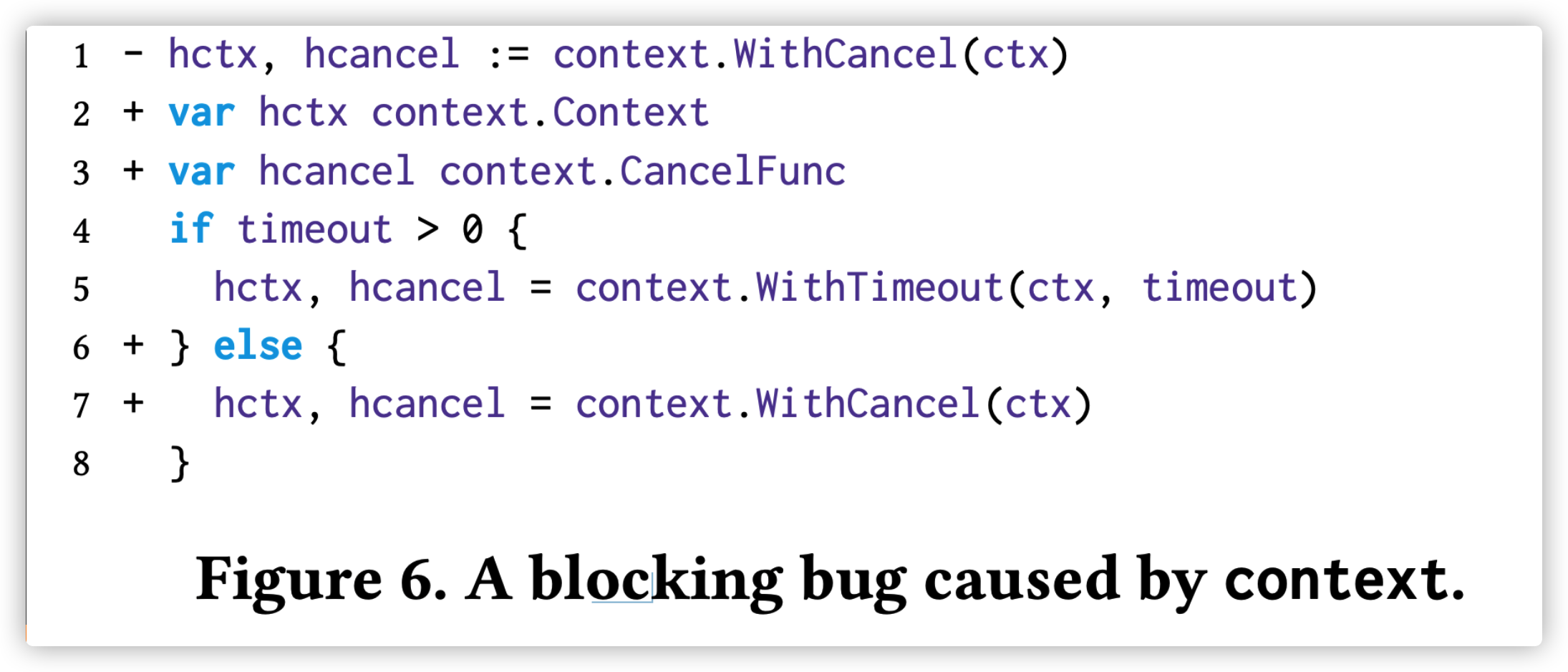
总结
到这里,整个 context 包的内容就全部讲完了。源码非常短,很适合学习,一定要去读一下。
context 包是 Go 1.7 引入的标准库,主要用于在 goroutine 之间传递取消信号、超时时间、截止时间以及一些共享的值等。它并不是太完美,但几乎成了并发控制和超时控制的标准做法。
使用上,先创建一个根节点的 context,之后根据库提供的四个函数创建相应功能的子节点 context。由于它是并发安全的,所以可以放心地传递。
当使用 context 作为函数参数时,直接把它放在第一个参数的位置,并且命名为 ctx。另外,不要把 context 嵌套在自定义的类型里。
最后,大家下次在看到代码里有用到 context 的,观察下是怎么使用的,肯定逃不出我们讲的几种类型。熟悉之后会发现:context 可能并不完美,但它确实简洁高效地解决了问题。
参考
The Go Blog: 关于 context 的一点最佳实践
深度解密Go语言之context
golang net/http输出context引起的map panic















